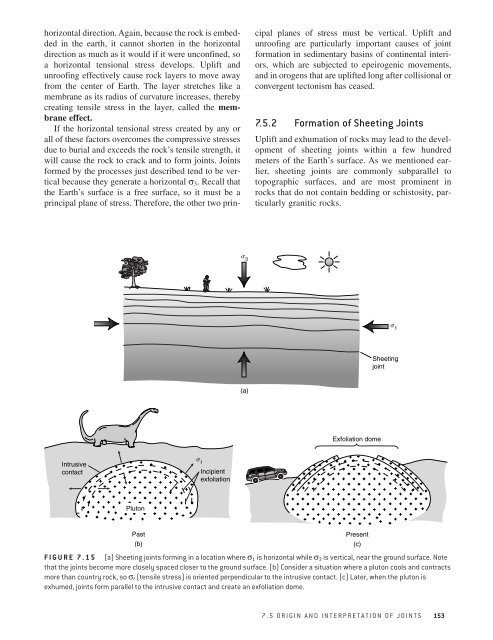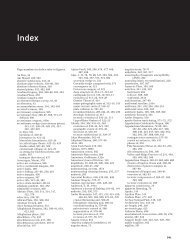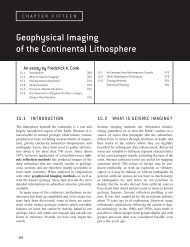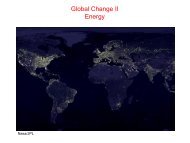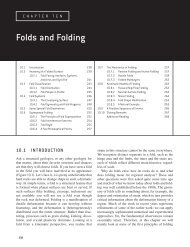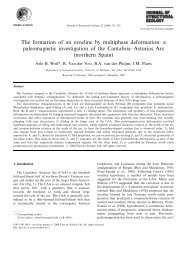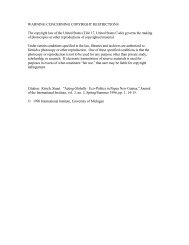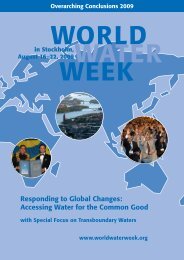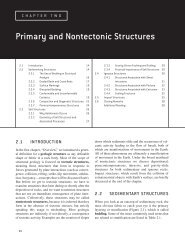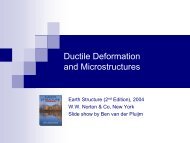2917-CH07.pdf 11/20/03 5:11 PM Page 153horizontal direction. Again, because the rock is embeddedin the earth, it cannot shorten in the horizontaldirection as much as it would if it were unconfined, soa horizontal tensional stress develops. Uplift <strong>and</strong>unroofing effectively cause rock layers to move awayfrom the center of Earth. The layer stretches like amembrane as its radius of curvature increases, therebycreating tensile stress in the layer, called the membraneeffect.If the horizontal tensional stress created by any orall of these factors overcomes the compressive stressesdue to burial <strong>and</strong> exceeds the rock’s tensile strength, itwill cause the rock to crack <strong>and</strong> to form joints. <strong>Joints</strong>formed by the processes just described tend to be verticalbecause they generate a horizontal σ 3 . Recall thatthe Earth’s surface is a free surface, so it must be aprincipal plane of stress. Therefore, the other two principalplanes of stress must be vertical. Uplift <strong>and</strong>unroofing are particularly important causes of jointformation in sedimentary basins of continental interiors,which are subjected to epeirogenic movements,<strong>and</strong> in orogens that are uplifted long after collisional orconvergent tectonism has ceased.7.5.2 Formation of Sheeting <strong>Joints</strong>Uplift <strong>and</strong> exhumation of rocks may lead to the developmentof sheeting joints within a few hundredmeters of the Earth’s surface. As we mentioned earlier,sheeting joints are commonly subparallel totopographic surfaces, <strong>and</strong> are most prominent inrocks that do not contain bedding or schistosity, particularlygranitic rocks. 3 1Sheetingjoint(a)Exfoliation domeIntrusivecontact tIncipientexfoliationPlutonPast(b)Present(c)FIGURE 7.15 (a) Sheeting joints forming in a location where σ 1 is horizontal while σ 3 is vertical, near the ground surface. Notethat the joints become more closely spaced closer to the ground surface. (b) Consider a situation where a pluton cools <strong>and</strong> contractsmore than country rock, so σ t (tensile stress) is oriented perpendicular to the intrusive contact. (c) Later, when the pluton isexhumed, joints form parallel to the intrusive contact <strong>and</strong> create an exfoliation dome.7.5 ORIGIN AND INTERPRETATION OF JOINTS153
2917-CH07.pdf 11/20/03 5:11 PM Page 154The origin of sheeting joints is a bit problematic. Atfirst glance, you might not expect joints to form parallelto the ground surface, because they are tensile fractures,<strong>and</strong> near the ground surface there is a compressiveload perpendicular to the ground surface due to theweight of the overlying rock, <strong>and</strong> the lack of high fluidpressure. It appears that sheeting joints form wherehorizontal stress is significantly greater than the verticalload (Figure 7.15a), allowing joints to propagateparallel to the ground surface. In this regard, formationof sheeting joints resembles cracks formed by longitudinalsplitting in laboratory specimens.The stresses causing sheeting joints may, in part,be tectonic in origin, but they may also be residualstresses. A residual stress remains in a rock even if itis no longer loaded externally (e.g., in an unconfinedblock of rock sitting on a table). Residual stressesdevelop in a number of ways. Imagine a layer of drys<strong>and</strong> that gets deeply buried. Because of the weight ofthe overburden, the s<strong>and</strong> grains squeeze together <strong>and</strong>strain elastically. If, at a later time, groundwater fillsthe pores between the strained grains, unstrainedcement may precipitate <strong>and</strong> lock the grains together.As a consequence, the elastic strain in the grains getslocked into the resulting s<strong>and</strong>stone. When unroofinglater exposes the s<strong>and</strong>stone, the grains <strong>and</strong> the cementexp<strong>and</strong> by different amounts, <strong>and</strong> as a consequencestress develops in the s<strong>and</strong>stone. In the case of pluton,residual stresses develop because its thermal properties(e.g., coefficient of thermal expansion) differfrom those of the surrounding wall rock, <strong>and</strong> because,during cooling, the pluton cools by a greater amountthan the wall rock. The pluton <strong>and</strong> the wall rock tendto undergo different elastic strains as a result of thermalchanges during cooling <strong>and</strong> later unroofing (Figure7.15b <strong>and</strong> c). Because the pluton is welded to thesurrounding country rock, the differential strain createsan elastic stress in the rock. For example, if thepluton shrinks more than the wall rock, tensilestresses develop perpendicular to the wall. At depth,compressive stress due to the overburden countersthese tensile stresses, but near the surface, residualtensile stress perpendicular to the walls of the plutonmay exceed the weight of the overburden <strong>and</strong> producesheeting joints parallel to the wall of the pluton.We earlier noted that sheeting joints tend to paralleltopography. This relationship either reflects topographiccontrol of the geometry of joints (because thevertical load is perpendicular to the ground surface), orjoint control of the shape of the l<strong>and</strong> surface (becauserocks spall off the mountainside at the joint surface).Geologists are not sure which phenomenon is moreimportant.7.5.3 Natural Hydraulic FracturingAs we saw in Chapter 3, the three principal stresses atdepth in most of the continental lithosphere are compressive.Yet joints form in these regions, <strong>and</strong> thesejoints may be decorated with plumose structure indicatingthat they were driven by tensile stress. Howcan joints form if all three principal stresses are compressive?As we described in Chapter 6, the solutionto this paradox comes from considering the effect ofpore pressure on fracturing. In simple terms, theincrease in pore pressure in a preexisting crackpushes outward <strong>and</strong> causes a tensile stress to developat the crack tip that eventually exceeds the magnitudeof the least principal compressive stress. If the porepressure is sufficiently large, a tensile stress thatexceeds the magnitude of σ 3 develops at the tip thecrack, even if the remote principal stresses are allcompressive (Figure 7.16a), <strong>and</strong> the crack propagates,a process called hydraulic fracturing. Oilwell engineers commonly use hydraulic fracturing tocreate fractures <strong>and</strong> enhance permeability in the rocksurrounding an oil well. They create hydraulic fracturesby increasing the fluid pressure in a sealed segmentof the well until the wall rock breaks. Buthydraulic fracturing also occurs in nature, due to thefluid pressure of water, oil, <strong>and</strong> gas in rock, <strong>and</strong> it isthis natural hydraulic fracturing that causes somejoints to form.If you think hard about the explanation of hydraulicfracturing that we just provided, you may wonderwhether the process implies that the pore pressure inthe crack becomes greater than pore pressure in thepores of the surrounding rock. It doesn’t! Pore pressurein the crack can be the same as in the pores of the surroundingrock during natural hydraulic fracturing.Thus, we need to look a little more closely at the problemto underst<strong>and</strong> why pore pressure can cause jointpropagation.Imagine that a cemented s<strong>and</strong>stone contains fluidfilledpores <strong>and</strong> fluid-filled cracks (Figure 7.16b).Let’s focus our attention on the crack <strong>and</strong> its walls.Because the pores <strong>and</strong> the crack are connected, thefluid pressure in the pores <strong>and</strong> the crack are the same.Fluid pressure within the crack is pushing outwards,creating an opening stress, but at the same time, thefluid pressure in the pores, as well as the stress in therock, is pushing inwards, creating a closing stress. Aslong as the closing stress exceeds the opening stress,the crack does not propagate. If the fluid pressureincreases, the opening stress increases at the samerate as the increase in fluid pressure, but the closingstress increases at a slower rate. Eventually, the open-154 JOINTS AND VEINS


